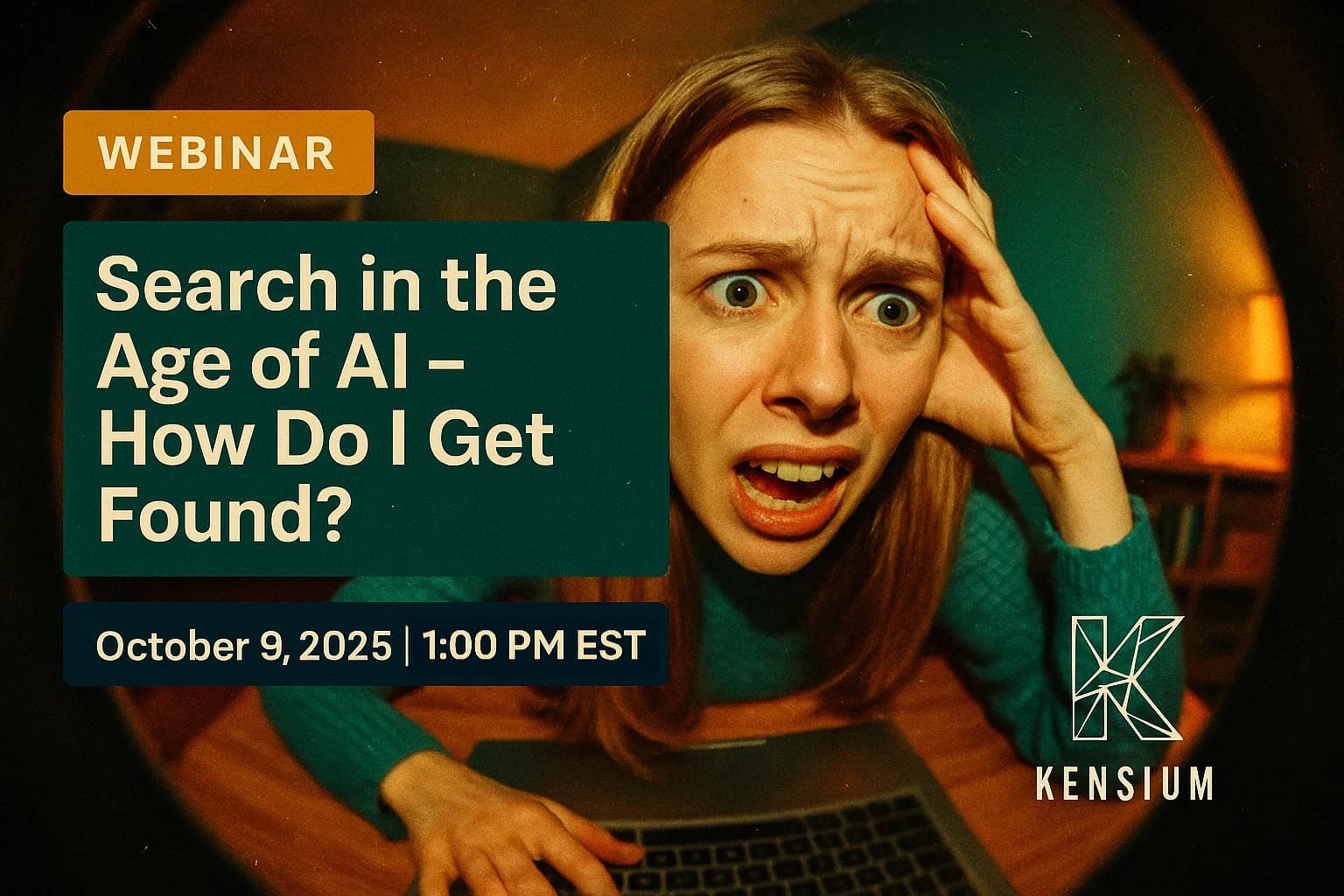
Where is the first place you look when searching for new marketing insights and ideas? You most likely answered “Google.” Google is a powerhouse of information and the number one place marketers strive to rank higher than their competitors. But, when understanding how to rank higher on search engines, one strategy reigns supreme – SEO.
What Is SEO?
Search Engine Optimization, aka SEO, is how you expand your online visibility in organic (unpaid) search results. SEO helps drive more visitors to your website and increases your chances for more people to purchase your product or service.
SEO is a strategy that ensures that when someone Googles your product or service category, your website appears on the first pages of a search engine result. But getting there is a challenge. Gone are the days of keyword-stuffing articles, using metadata and alt text to add keywords to every piece of content on your site. Those tactics will penalize you rather than help you.
So, how do you implement SEO in today’s digital world? Read on, and we’ll go through the best ways to use SEO for your business.
Three Types Of SEO
Every business needs to integrate three types of SEO into its marketing strategy. When combined, the three types of SEO work together and increase organic traffic to your website.

1. On-Page SEO
On-page SEO is the type most marketers are familiar with. It involves optimizing your website’s content and source code to increase visibility on search engine results pages (SERPs). A good strategy for on-page SEO is to serve users with high-quality content based on specific search queries.
To break it down further, the goal of on-page SEO is to help search engines and users to:
- Quickly understand the context of a web page
- Identify the page as relating to the search terms used
- Locate a page that’s optimized to rank well on SERPs
Previously, on-page SEO focused on conventional methods like exact-match keywords placed strategically on individual pages. However, search engines have evolved to find the meaning of your page using synonyms, word combination frequency, and context. This allows you to focus on the relevance of content and how it relates to user intent. On-page SEO should have detailed, unique, trustworthy, user-friendly content aligned with how users search for products and services like yours.
2. Off-Page SEO
A lesser-known form of SEO is off-page SEO. This refers to actions outside your website that impact your search engine rankings. Off-page SEO helps instill trust and authority in your business and products. In addition, it helps improve the perception of your site’s popularity and relevance in digital spaces. You can use two main off-page SEO types to boost your website’s credibility and relevance.
- Link-related SEO – The core of off-page SEO is backlinking. Search engines use these backlinks to indicate the quality of your content, and high-value backlinks help rank your site higher in search engine results. There are three types of backlinks:
- Natural Links – given without any action needed by the website owner. For example, a blogger links to one of their favorite products without being sponsored by your business.
- Manually built links are acquired through deliberate link-building activities like sponsoring influencers or incentivizing customers to share your content. For example, let’s say you’re running a contest for existing customers to share a social media post and comment that they’ve shared it.
- Self-created links – These links are created by adding a backlink in an online directory, blog comment signature, or press release.
- Non-Link Related SEO – This strategy is essential to improving search rankings. This form of SEO drives your website's traffic from other platforms like social media or influencers. Posting your content on social media or having an influencer mention your brand triggers search engines to collect data from outside sources and can help increase your ranking.
3. Technical SEO
Technical SEO rounds out the three types of SEO you need to use in your marketing strategy. It refers to non-content elements of your site, like improved backend structure and the foundation of your website. This SEO improves a site’s readability, allowing search engines to crawl your site effectively and providing a good user experience. By ensuring your site offers a good user experience, you’re telling search engines that you have a high-quality website and should appear more prominently in search results. Some of the site components search engines crawl for are:
- Low page load speeds
- Mobile friendly
- Easy to crawl and index
- Good site architecture
- Structured data
- Security
To develop an effective SEO strategy that leads to actual results, you need to leverage all three types of SEO. Want to know more? Contact our Marketing Services team, and let’s talk about how we can improve your SEO.
-1.png)
Get To The Top!
Now that we’ve taken you through what SEO is and the types, let’s look at strategies you can implement to boost your website to the top of search engine results pages (SERPs). You may already know some of these, but for 2023, here are the top 5 best practices to help increase traffic.

1. Keyword Search & Use
Keywords are groups of words based on the content of your webpage or blog. These keywords describe your page or post in the best way possible because they’re based on a user’s search behavior and intent.
Here’s an example: When searching Google, a list of predictive search terms appears. In this instance, we searched for “the best donuts near me.”

One major clue for Google is keyword density – the number of times your focus keyphrase occurs in your copy compared to the total text of the page. This doesn’t mean “stuffing” your keyphrase or the keyword all over your web page or blog post, but strategically using it in areas like titles, headers, and blog content helps Google evaluate the content as relevant and human-centric and rank your site higher.
2. Use Unique Titles, Meta Descriptions, and Content
Many businesses like taking shortcuts and " borrowing” content from other blogs. This is plagiarism; when Google notices plagiarism, they show it to fewer people. In addition, the more unique your content, the higher your ranking. If you’re not sure about plagiarism, there are tools you can use to check your content for originality. A few free plagiarism checkers are Grammarly, Duplichecker, and QueText.
Next is to use unique titles and meta descriptions. Look for different ways to title your pages and blog posts. Get creative, and use list titles (Top 10 Ways To Use SEO), tips and tricks, or FAQs. Remember to use the keyword in your titles to help Google find it throughout the page. Meta descriptions are the snippet that displays in search results. These descriptions need to be unique and not match your title.
Here is an example of a unique meta description that conveys the business message without duplicating page content.
-1.png)
3. Improve User Experience
Google also ranks your website based on how users interact with your content. Improving the user experience by adding human-centric and easy-to-understand content is the best way to improve the user experience. In addition, creating a clear sitemap, structure, and mobile design are essential parts of your SEO strategy. Page speed is another crucial component to improving the user’s experience with your website. You can use Google's core web vitals to judge a website visitor's experience. Core Web Vitals are:
- First Contentful Paint (FCP): This is the time taken when a browser first renders content (text, images, graphics, etc.) from the document object model (DOM).
- Largest Contentful Paint (LCP): Measures the time taken for the longest piece of content, like an image or block of text, appears on the screen.
- Cumulative Layout Shift (CLS): Evaluates the visual stability of a website. For example, when a webpage is loading, bots check if images or content move around the screen.
- First Input Delay (FID): The time a site takes to respond to the first interaction, like clicking a button.
-1.png)
4. Emphasize the Author's Authority
Google wants to know that real people produce your content. As AI infiltrates the content creation space, establishing an author as an authentic, experienced human being is more important now than ever. There are a few ways to emphasize an author’s authority:
- Include author bios to communicate the writer’s knowledge and area of expertise.
- Create pages where you link to all the articles the author writes on your website.
- Link the creator’s social media accounts so Google quickly understands through social signals that they are real people and experts.
We can’t stress enough that content needs to relate to human users and establish credibility through authorship.
5. Image SEO
Images are often neglected but essential to your SEO strategy, especially in getting better rankings for image searches. Google wants to see alt text and schema markup to help crawlers understand the content of images. Alt text also helps with accessibility and allows screen readers to describe an image for the visually impaired or those limited by internet bandwidth and connectivity issues.
Kensium Design And Marketing Services
Kensium's entire marketing department is built around helping clients create and execute effective marketing campaigns. We help businesses create well-designed websites that follow SEO best practices, and content created by real humans relevant to search queries and user behavior. Let us help increase brand awareness and boost your site in search results. Contact us today and learn more about our flexible marketing retainers.








.png)






